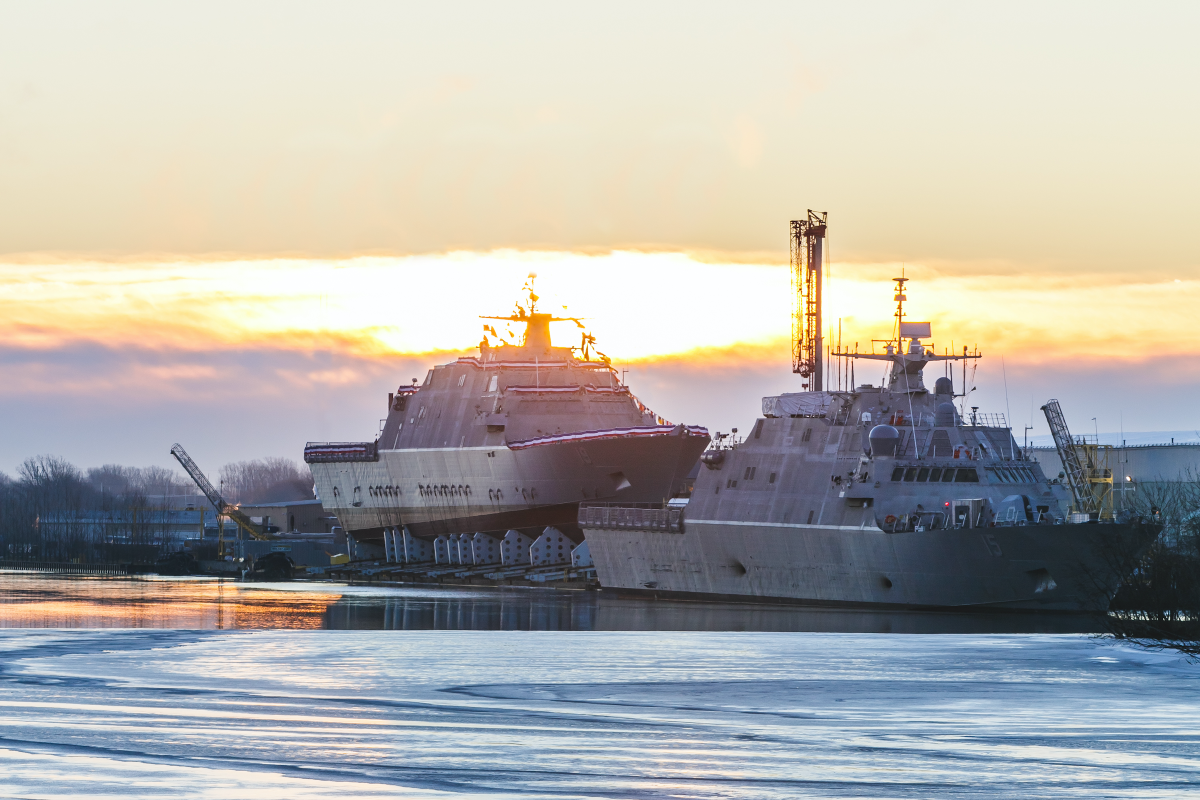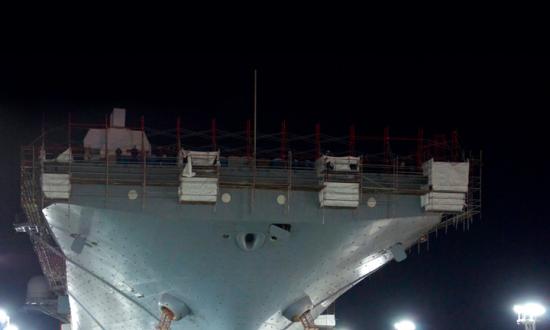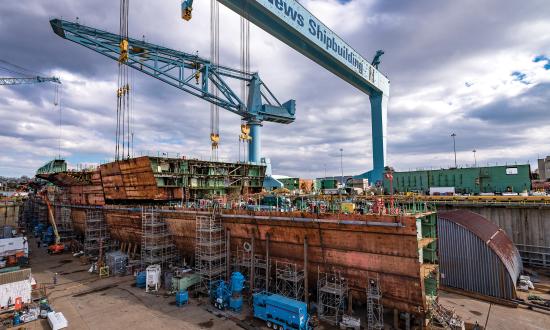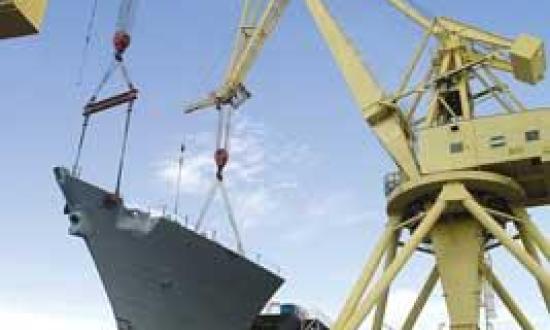As tensions mounted between Great Britain and Imperial Germany in the years leading up to World War I, there was a “naval scare” in 1909. It seemed Berlin was about to match or potentially surpass London’s construction on the new Dreadnought class of battleships. German industry had surpassed British industry in total output after decades of high economic growth had closed the gap, ultimately giving Germany Europe’s largest economy and changing the balance of power. There are similarities and lessons from the Anglo-German naval arms race relevant to the current Sino-American naval arms race that has accompanied Beijing’s rise in economic strength.
HMS Dreadnought was launched in 1905 at the direction of Admiral Sir John Fisher, who had been elevated to First Sea Lord in 1904. The revolutionary design increased from four to ten the number of heavy (12-inch) guns in capital ships and would see the size of main guns (13.5 and 15 inch) increase as the design matured. The Royal Navy’s superiority was at risk, as all powers started at zero with the new design.
In 1906, Germany adopted a plan to build three dreadnoughts per year. Britain’s Unionist government (an alliance of the Conservative Party and Liberal-Imperialist faction) had planned four dreadnoughts per year, but it was voted out of office in 1905. The Liberal Party, committed to reduced military spending in favor of social programs, cut the building program to three per year in 1906 and 1907, and then to only two in 1908. That same year, Germany increased its battleship construction to four. London could still build ships faster than Berlin could (two years against three), but there were signs that German industry was closing this gap, producing guns and armor for the High Seas Fleet in anticipation of the Reichstag funding new ships.
In 1909, the Admiralty requested Parliament fund six battleships. Prime Minister Herbert Asquith and Chancellor of the Exchequer David Lloyd George wanted to reject this proposal, offering instead a return to the four-per-year plan. They were not convinced that Germany posed a threat. The debate prompted Norman Angell to write his landmark book The Great Illusion. Angell argued that any naval buildup was wasteful because trade and global finance had so entangled the major economies that war was impossible. He was proven wrong in 1914, and Asquith and Lloyd George (who would each serve as prime minister during the war) were glad the Royal Navy had a 29 to 17 edge in dreadnoughts. Yet, Angell’s vision of a globalized economy so interdependent that national conflicts were no longer feasible or even relevant to world affairs never died. He was awarded the Nobel Peace Prize in 1933—the same year Adolf Hitler became Chancellor of Germany. In 1938, the prominent British publishing house Penguin put out a special edition of The Great Illusion. That was the year of the infamous Munich conference. His idea reemerged again after the Cold War, with the supposed triumph of Western-style capitalism and an explosion of world trade.
Even today, many of those who thought history had come to an end with the fall of the Berlin Wall cling to that hope. Robert Zoellick, U.S. Trade Representative when China was admitted into the World Trade Organization and later President of the World Bank, lamented to the BBC in September 2020 that “the world could look more like the world of 1900 when the great powers were in competition” if countries start to pull back from globalization to pursue national interests; and that the rift between the United States and China is a serious threat to the world economy.
Beijing’s thinking along these lines, however, has taken a different course than Angell’s. Today, China is using interdependence not to promote peace but to gain power and national advantages through the use of leverage. Beijing has a stranglehold on international supply chains in many strategic products. A China Daily essay last April proclaimed, “Global Reliance on China Won’t Reduce.” The state-run paper argued: “Even if more regionalized and diversified supply chains would reduce risks, China retains considerable competitive advantages in many areas, such as electronics and machinery and equipment manufacturing. It cannot be replaced, at least not in the near term . . . [and] the world may now be more dependent on China than China is on the world.” One of those areas in which China has become the leader is commercial shipbuilding, a sector the United States has allowed to slip away. This gives Beijing considerable mobilization potential to accelerate warship construction, especially as it is pushing a civil-military integration program to spur efficiency and innovation.
In 1909 Britain, the Liberal government came under public pressure to increase naval spending as concern about Germany spread. The popular cry went up: “We want eight and we won’t wait.” This was in response to the Admiralty’s strategy of raising its request from six battleships to eight to strengthen its bargaining power. Asquith’s counteroffer was to authorize four in the regular budget but to hold another four in reserve if German actions warranted a response. German behavior continued on its menacing course, and the extra four battleships were laid down. As Winston Churchill put it, “The Admiralty had demanded six ships; the economists offered four, and we finally compromised on eight.”
Under the U.S. Navy’s fiscal year (FY) 2020 30-year shipbuilding plan, the fleet would only be getting six warships per year on average as a base. This is counting surface combatants and attack submarines, but not support vessels, ballistic-missile submarines, amphibious warfare ships, or aircraft carriers (only seven of which are planned over the next 30 years). The six warships will consist of two each of large surface combatants (LSCs—cruisers and destroyers), small surface combatants (SSCs—littoral combat ships and frigates), and nuclear-powered attack submarines (SSNs). In 2020, from 2023 to 2025, and then every other year thereafter, a third LSC would have been added, to bring the yearly total to seven. However, the FY 2021 request cut this back for the 2021 to 2025 period by seven ships (5 LSCs, 1 SSC, and 1 SSN). Under the FY 2020 plan, the target of a 355-ship fleet would not to be reached until 2034. Any reductions push that date even farther into the future.
President Ronald Reagan’s goal of a 600-ship fleet was (almost) reached near the end of his second term by building twice as many ships per year as planned today. Meanwhile, China may add 32 warships to its fleet by 2025 (11 LSCs, 18 SSCs, and 3 SSNs). This would put Beijing on par with the FY 2020 plan, but ahead of the downwardly revised FY 2021 request. The People’s Liberation Army Navy (PLAN) is predicted to have 400 warships by 2024 and 425 by 2030, well ahead of the U.S. Navy even under its most ambitious program.
The U.S. fleet still holds a substantial qualitative advantage. The PLAN has gained its numerical edge by the rapid construction of some 50 new Type 058 corvettes since 2013, hardly compensation for lagging well behind in aircraft carriers and nuclear submarines. And the U.S. Navy has skilled crews who can draw on a much deeper legacy of operational experience. However, the PLAN holds the strategic advantage of having a fleet concentrated in the contested theater while the U.S. Navy is spread across global deployments. This is the same problem the United States faced at the start of World War II against the Japanese threat, and it suffered accordingly as it fought outnumbered during the first year of the conflict. Had President Franklin Roosevelt not started industrial mobilization three years before Pearl Harbor, even the victory at Midway would not have decisively turned the war around, as shown by the costly naval battles around Guadalcanal.
The Naval Act of 1938 authorized a 20 percent increase in the size of the fleet and was followed by more shipbuilding legislation, so that by July 1940 some 80 warships were under construction. And that month, another act passed calling for 11 more battleships, 11 aircraft carriers, 50 cruisers, and 100 destroyers. These were the ships that would enter combat in 1943 and 1944 to ensure victory at sea worldwide. The first of the Essex-class carriers was authorized in 1938, the same year the iconic B-17 Flying Fortress heavy bomber entered service. Waiting until a war starts is too late to prepare for it.
The pre–World War I Royal Navy faced the same geography problem as the High Seas Fleet expanded. It withdrew capital ships from distant waters to concentrate in the North Sea. It had to rely on allies such as France in the Mediterranean and Japan in the western Pacific to maintain stability and keep sea lanes open. The United States today has a global system of alliances and alignments that could allow an even greater concentration of ships, aircraft, and personnel in the Indo-Pacific theater than is currently being done. But Washington cannot abandon all its military support for NATO, in the face of an assertive Russia, or the Israeli-Arab coalition against a militant Iran. It must expand the forces confronting China along the First Island Chain through its own naval expansion, as redeployment alone will not suffice. It should also encourage (and be appreciative of) naval expansion by India, Japan, and Australia, all of whom are increasing their cooperation in response to Chinese provocations.
In early October, then–Secretary of Defense Mark Esper proposed “Battle Force 2045,” which aims for a fleet of 500 manned and unmanned ships by 2045, and which recommitted to 355 manned ships by 2035. Key to reaching this target was his call for building three SSNs a year instead of just two. If a third LSC were added to those even-numbered years in the FY 2020 plan (which only requests two), the baseline program would be brought up to eight combatants per year (three LSCs, two SSCs, and three SSNs).
And we need those eight and cannot wait in the face of the trend in Chinese warship construction. The fleet would reach its goal of 355 manned combatants three years sooner. An emphasis on the LSC also provides platforms that can be adapted to the new weapons and other systems that will emerge over the coming decades. Yet, political and budgetary uncertainty casts a shadow over Esper’s ambitious plans (which included a number of other innovations), as he was dismissed less than a week after the 2020 election.
Establishing a standard, sustainable “normal” shipbuilding program large enough to meet the demands of the new era of great power competition is key to having a 30-year program that can survive the inevitable political swings over such a long period in a democracy. The Royal Navy survived such swings in the critical years before World War I by making its strategic case not only to those in office, but to the public who put them there. American naval strategists need to do the same today, as polls indicate a broad, bipartisan consensus is forming in support of meeting the challenge of a rising China.






